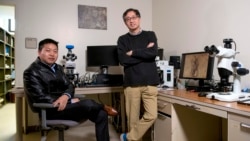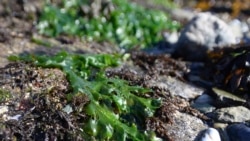Scientists have discovered what may be the oldest fossils of a green plant ever found.
The fossils were found in rocks from northern China. The plant is thought to be a piece of seaweed that grew on Earth’s seafloor about 1 billion years ago. That would make this seaweed an ancestor of all green plants alive today.
Researchers in the United States reported on the discovery in the publication Nature Ecology & Evolution. The researchers are with the Virginia Polytechnic Institute and State University in Blacksburg, Virginia.
The seaweed is a form of green algae called Proterocladus antiquus. It was very small, about the size of a single piece of rice. Researchers say the plant was connected to the seafloor with a root-like structure. At the time, the plant was one of the largest life forms in the sea, which contained mostly bacteria and other microorganisms.
The researchers say Proterocladus was able to perform photosynthesis, taking energy from the sun to produce life-supporting carbon and oxygen. They believe the plant also provided food and shelter for many different kinds of sea life.
Shuhai Xiao serves as a Professor of Geobiology at Virginia Tech. He said the fossils were found in rock taken from an area of dry land - formerly ocean - near the city of Dalian in China’s Liaoning Province. Qing Tang, another Virginia Tech researcher, discovered the micro-fossils in the rock using an electronic microscope in a laboratory.
Xiao said the fossils represent the oldest green seaweed ever found. The next oldest fossil of green seaweed was found in rock thought to be about 800 million years old.
The scientists say the seaweed once lived in an ocean that was not very deep. Once the plants died, they became “cooked” under thick sediment, which created fossils in the shape of the seaweed. Many millions of years later, the dirt was lifted out of the ocean and became the dry land where the examples were collected.
“These new fossils suggest that green seaweeds were important players in the ocean long before their land-plant descendants moved and took control of dry land,” Xiao said.
He added that Earth’s biosphere depends heavily on plants for food and oxygen. But the first land plants, believed to be ancestors of green seaweeds, did not appear until about 450 million years ago.
The Virginia Tech researchers believe that land plants – including trees, grasses food crops and others – all developed from green seaweeds that lived in the ocean. Then, over millions of years, the seaweed plants moved out of the water and adapted to life on land.
The history of how green plants developed is a subject of debate. “Some scientists think that green plants started in rivers and lakes, and then conquered the ocean and land later,” Xiao said.
Proterocladus is believed to be closely related to a modern seaweed, widely eaten by humans today. It is called sea lettuce.
I’m Bryan Lynn.
Bryan Lynn wrote this story for VOA Learning English, based on reports from Reuters, Virginia Tech and Nature Ecology & Evolution. George Grow was the editor.
We want to hear from you. Write to us in the Comments section, and visit our Facebook page.
________________________________________________________________
Words in This Story
fossil – n. remains of an animal or plant from the past that are found in rock
algae – n. a simple plant that grows in or near water
sediment – n. a solid substance that forms a later at the bottom of a liquid
descendant – n. someone related to someone who lived a long time ago
biosphere – n. the part of the Earth’s environment where life exists
adapt – v. to change for a new purpose or use
conquer – v. to defeat or take control of something












